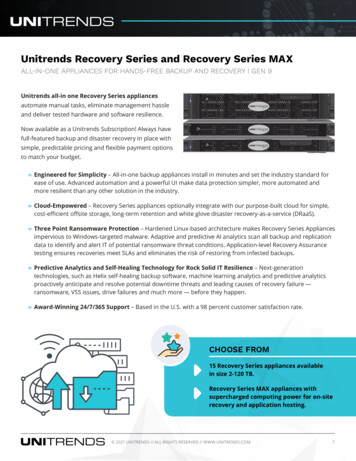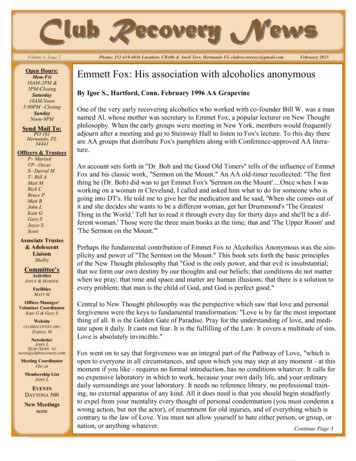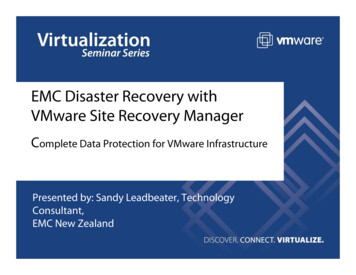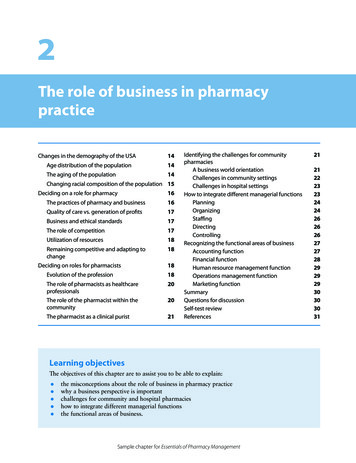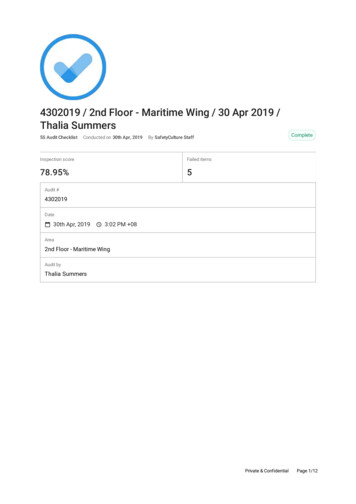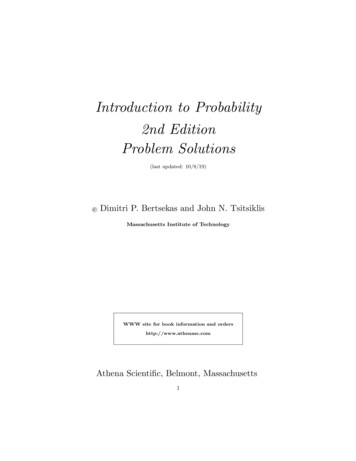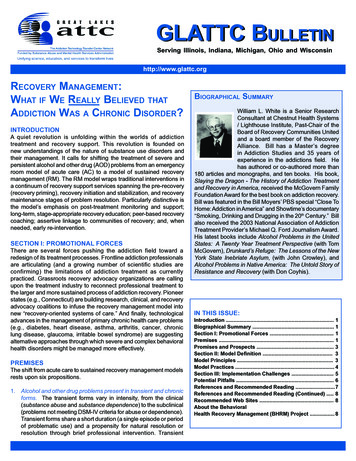
Transcription
GLATTC BULLETINServing Illinois, Indiana, Michigan, Ohio and Wisconsinhttp://www.glattc.orgRECOVERY MANAGEMENT:WHAT IF WE REALLY BELIEVED THATADDICTION WAS A CHRONIC DISORDER?INTRODUCTIONA quiet revolution is unfolding within the worlds of addictiontreatment and recovery support. This revolution is founded onnew understandings of the nature of substance use disorders andtheir management. It calls for shifting the treatment of severe andpersistent alcohol and other drug (AOD) problems from an emergencyroom model of acute care (AC) to a model of sustained recoverymanagement (RM). The RM model wraps traditional interventions ina continuum of recovery support services spanning the pre-recovery(recovery priming), recovery initiation and stabilization, and recoverymaintenance stages of problem resolution. Particularly distinctive isthe model’s emphasis on post-treatment monitoring and support;long-term, stage-appropriate recovery education; peer-based recoverycoaching; assertive linkage to communities of recovery; and, whenneeded, early re-intervention.SECTION I: PROMOTIONAL FORCESThere are several forces pushing the addiction field toward aredesign of its treatment processes. Frontline addiction professionalsare articulating (and a growing number of scientific studies areconfirming) the limitations of addiction treatment as currentlypracticed. Grassroots recovery advocacy organizations are callingupon the treatment industry to reconnect professional treatment tothe larger and more sustained process of addiction recovery. Pioneerstates (e.g., Connecticut) are building research, clinical, and recoveryadvocacy coalitions to infuse the recovery management model intonew “recovery-oriented systems of care.” And finally, technologicaladvances in the management of primary chronic health care problems(e.g., diabetes, heart disease, asthma, arthritis, cancer, chroniclung disease, glaucoma, irritable bowel syndrome) are suggestingalternative approaches through which severe and complex behavioralhealth disorders might be managed more effectively.PREMISESThe shift from acute care to sustained recovery management modelsrests upon six propositions.1. Alcohol and other drug problems present in transient and chronicforms. The transient forms vary in intensity, from the clinical(substance abuse and substance dependence) to the subclinical(problems not meeting DSM-IV criteria for abuse or dependence).Transient forms share a short duration (a single episode or periodof problematic use) and a propensity for natural resolution orresolution through brief professional intervention. TransientBIOGRAPHICAL SUMMARYWilliam L. White is a Senior ResearchConsultant at Chestnut Health Systems/ Lighthouse Institute, Past-Chair of theBoard of Recovery Communities Unitedand a board member of the RecoveryAlliance. Bill has a Master’s degreein Addiction Studies and 35 years ofexperience in the addictions field. Hehas authored or co-authored more than180 articles and monographs, and ten books. His book,Slaying the Dragon - The History of Addiction Treatmentand Recovery in America, received the McGovern FamilyFoundation Award for the best book on addiction recovery.Bill was featured in the Bill Moyers’ PBS special “Close ToHome: Addiction in America” and Showtime’s documentary“Smoking, Drinking and Drugging in the 20th Century.” Billalso received the 2003 National Association of AddictionTreatment Provider’s Michael Q. Ford Journalism Award.His latest books include Alcohol Problems in the UnitedStates: A Twenty Year Treatment Perspective (with TomMcGovern), Drunkard’s Refuge: The Lessons of the NewYork State Inebriate Asylum, (with John Crowley), andAlcohol Problems in Native America: The Untold Story ofResistance and Recovery (with Don Coyhis).IN THIS ISSUE:Introduction . 1Biographical Summary . 1Section I: Promotional Forces . 1Premises . 1Promises and Prospects . 3Section II: Model Definition . 3Model Principles . 3Model Practices . 4Section III: Implementation Challenges . 5Potential Pitfalls . 6References and Recommended Reading . 7References and Recommended Reading (Continued) . 8Recommended Web Sites . 8About the BehavioralHealth Recovery Management (BHRM) Project . 8
http://www.glattc.orgAOD problems are common in community populations, butare more rarely represented among populations enteringaddiction treatment. Compared to community populations,clients entering addiction treatment are distinguished by:–––––treating severe and persistent AOD problems. The limitationsof the acute model of addiction treatment as currentlypracticed include:–greater personal vulnerability (e.g., family history ofsubstance use disorders, early age of onset of AOD use,developmental trauma)greater severity and intensity of use and relatedconsequenceshigh concurrence of medical/psychiatric illnessesgreater personal and environmental obstacles torecoveryless “recovery capital” (the internal and external resourcesrequired to initiate and sustain recovery)––2. The evidence is overwhelming that the course of severesubstance use disorders and their successful resolution(addiction, treatment, and recovery careers) can spanyears, if not decades. Alcohol and other drug dependenciesresemble chronic disorders (e.g., type 2 diabetes mellitus,hypertension, and asthma) in their etiological complexity(interaction of genetic, biological, psychological, and physical/social environmental factors), onset (gradual), course(prolonged waxing and waning of symptoms), treatment(management rather than cure), and clinical outcomes. Tocharacterize addiction as a chronic disorder is not to suggestthat recovery is not a possibility. There are millions of peoplein stable, long-term recovery from addiction. The notion ofaddiction as a chronic disorder does, however, underscorethe often-long course of such disorders and the sustained“treatment careers” that can precede stable recovery. Recentstudies have confirmed that the majority of people with severeand persistent substance use disorders (i.e., substancedependence) who achieve a year of stable recovery doso following 3-4 treatment episodes over a span of eightyears.–––Failure to Attract: Less than 10% of U.S. citizens whomeet DSM-IV criteria for substance abuse or dependencecurrently seek treatment, and most of those admitted totreatment arrive under coercive influences.Failure to Engage/Retain: More than half of the peopleadmitted to addiction treatment in the U.S. do notsuccessfully complete treatment, and 18% of peopleadmitted to addiction treatment are administrativelydischarged from treatment.Inadequate Service Dose: A significant percentage ofindividuals completing treatment receive less than theoptimum dose of treatment recommended by the NationalInstitute on Drug Abuse.Lack of Continuing Care: Post-discharge continuingcare can enhance recovery outcomes, but only one infive clients actually receives such care.Recovery Outcomes: The majority of people completingaddiction treatment in the U.S. resume AOD use in theyear following treatment, most within 90 days of dischargefrom treatment.Revolving Door: Of those admitted to publicly fundedaddiction treatment, 60% already have one or moreprior treatment admissions, and 24% have three or moreprior admissions. Between 25% and 35% of clientswho complete addiction treatment will be re-admitted totreatment within one year, and 50% will be re-admittedwithin 2-5 years.A large number of people are undergoing repeated episodesof brief interventions whose designs have little ability tofundamentally alter the trajectory of substance dependenceand its related consequences. This failure does not result fromclient foibles or the inadequate execution of clinical protocolby service professionals. It flows instead from a fundamentalflaw in the design of the intervention - an acute-care modelof treating addiction that is analogous to treating diabetes orasthma through a single, self-contained episode of inpatientstabilization. In the AC model, brief symptom stabilization ismisinterpreted as evidence of sustainable recovery.3. Severe and persistent AOD problems have been collectivelydepicted as a “chronic, progressive disease” for morethan 200 years, but their historical treatment more closelyresembles interventions into acute health conditions (e.g.,traumatic injuries, bacterial infections). If we (the practitionersof addiction treatment) really believed addiction was a chronicdisorder, we would not:5. Most people discharged from addiction treatment areprecariously balanced between recovery and re-addictionin the weeks, months, and years following treatment.Recent studies have confirmed the fluidity of post-treatmentadjustment. One such study conducted quarterly monitoringinterviews of 1,326 clients over three years following an indexepisode of addiction treatment. Each client was categorizedeach quarter as 1) in the community using, 2) incarcerated,3) in treatment, or 4) in the community not using. More than80% of the clients changed status one or more times overthe course of the three years. Beyond the groups of clientswho categorically succeed or do not succeed stands a largerbody of clients who vacillate between periods of recoveryand periods of re-addiction. The precarious nature of earlyrecovery is further confirmed by longer-term studies finding–view prior treatment as predictor of poor prognosis (andgrounds for denial of treatment admission)– convey the expectation that all clients should achievecomplete and enduring sobriety following a single, briefepisode of treatment– punitively discharge clients for becoming symptomatic– relegate post-treatment continuing care services to anafterthought– terminate the service relationship following briefintervention– treat serious and persistent AOD problems in serialepisodes of self-contained, unlinked interventions4. Acute models of treatment are not the best frameworks for2
http://www.glattc.orgSECTION II: MODEL DEFINITIONThe recovery management model of addiction treatment shiftsthe focus of care from professional-centered episodes of acutesymptom stabilization toward the client-directed managementof long-term recovery. It wraps traditional interventions within amore sustained continuum of:that stable recovery from alcoholism (the point at whichthe future risk of lifetime relapse drops below 15%) is notachieved until 4-5 years of continuous recovery, and thatstable recovery from opiate addiction takes even longer.Such findings beg for models of sustained post-treatmentmonitoring and support.1.pre-recovery support services to enhance recoveryreadiness2. in-treatment recovery support services to enhance thestrength and stability of recovery initiation, and3. post-treatment recovery support services to enhance thedurability and quality of recovery maintenance.PROMISES AND PROSPECTSRecovery management models hold great promise in treatingsevere and complex substance use disorders. Chronic disordersare disorders that resist cure via brief intervention but can oftenbe successfully managed (the achievement of full or partialrecovery). Such management entails care and sustainedsupport aimed at enhancing the strength, quality, and durabilityof remission periods and shortening the frequency, duration,and intensity of relapse episodes. This longer-term vision ofthe treatment and recovery process is based on several criticalassumptions:The influence of this emerging model is evident in many quarters.It is evident in the research community’s exploration of addictionas a chronic disease (O’Brien & McLellan, 1996; McLellan,Lewis, O’Brien & Kleber, 2000). It is reflected in the work ofthe Behavioral Health Recovery Management project in Illinois(White, Boyle & Loveland, 2003a/b) and other pioneer stateefforts to reshape addiction treatment into a “recovery orientedsystem of care” (e.g., see http://www.dmhas.state.ct.us/recovery.htm). Interest in recovery management at the federal level isrevealed in the move toward a more recovery-oriented researchagenda at NIAAA and NIDA, in SAMHSA and CSAT’s growinginterest in peer-based models of recovery support services(particularly within CSAT’s Recovery Community SupportProgram), and in the White House-initiated Access to Recoveryprogram. Private sector interest in recovery-focused treatmentsystem enhancements is reflected in the Robert Wood Johnson’sPaths to Recovery Initiative (http://www.pathstorecovery.org).The shift from acute intervention models to models of sustainedrecovery support are further reflected in the policy agendas of newgrassroots recovery advocacy organizations across the country(see http://www.facesandvoiceofrecovery.org).1. A single brief episode of treatment rarely has sufficient effectfor those with the most severe substance use disorders (i.e.,substance dependence) to sustain recovery following theintervention.2. Multiple episodes of treatment, if they are integrated withina recovery management plan, can constitute incrementalsteps in the developmental process of recovery.3. Treatment episodes over time may generate cumulativeeffects.4. Particular combinations and sequences of professionaltreatment interventions and peer-based recovery supportservices may generate synergistic effects (dramaticallyelevated long-term recovery outcomes).RM models are focusing initially on the power of post-treatmentmonitoring and recovery support services. Early studies areconfirming the potential utility of such approaches. One study ofrecovery management checkups (RMC) and early re-interventionover 24 months following treatment found that members ofthe RMC group had significantly fewer post-treatment days ofsubstance use, were more likely to return to treatment, weremore likely to return to treatment sooner, received treatmenton a greater number of days following discharge from the indexepisode, and experienced fewer quarters during follow-up inwhich they were in need of treatment.Describing the emerging “model” of recovery management is a bitlike describing a painting while it is being created, but there arebroad principles and early changes in clinical practices that arebecoming visible.There may be no single program in the countrythat reflects all the changes described below, but these changesdo collectively represent what is increasingly being characterizedas a model of recovery management.MODEL PRINCIPLESTreating alcohol and other drug dependence solely throughrepeated episodes of detoxification and brief stabilizationis clinically ineffective and constitutes a poor stewardshipof personal and community resources. It contributes to thepessimism of clients, service providers, policy makers, andthe public regarding the prospects for permanent resolution ofalcohol and other drug problems. It is time we acted as if wereally believed addiction was a chronic disorder. Today millionsof people are reaping the fruits of recovery while others continueto suffer. It is time we widened the doorway of entry into recoveryfor those with the most severe and persistent substance usedisorders. To achieve that will require changes in our thinking,changes in our clinical technologies, and changes in systems ofservice reimbursement.There are several cornerstone beliefs that distinguish therecovery management model from acute models of addictiontreatment. These principles and values include:1. emphasis on resilience and recovery processes (asopposed to pathology and disease processes)2. recognition of multiple long-term pathways and stylesof recovery3. empowerment of individuals and families in recovery todirect their own healing4. development of highly individualized and culturallynuanced services5. heightened collaboration with diverse communities ofrecovery, and3
http://www.glattc.org6. commitment to best practices as identified in thescientific literature and through the collective experienceof people in recovery. les.htm and http://www.dmhas.state.ct.us/corevalues.htm)The traditional professionally-directed, short-term treatment planof the acute care model is replaced in the RM model by long-termand short-term recovery plans prepared by the person seekingrecovery. The former focuses primarily on reducing pathology;the latter focuses on building recovery capital and a meaningfullife.MODEL PRACTICESWhite, Boyle and Loveland’s (2003a/b) review of recoverymanagement (RM) pilot programs reveals several criticaldifferences between the RM models and traditional acute care(AC) models of intervention. These differences span seven broadareas of clinical practice.Service Duration and Emphasis: Acute care models do anexcellent job of biopsychosocial stabilization, but often fail tofacilitate the transition between recovery initiation and recoverymaintenance. The evidence of such failure can be found in posttreatment relapse and treatment re-admission rates (see Section1). Recovery management models rest on the assumption that thefactors required to sustain recovery over a lifetime are differentthan those factors that spark brief sobriety experiments. Therecovery management model emphasizes four post-treatmentservice activities: sustained post-stabilization monitoring, stageappropriate recovery education and coaching, assertive linkageto local communities of recovery, and, when needed, early reintervention. Detoxification and traditional treatment exist withinRM models, but the focus of service shifts from crisis interventionto post-treatment recovery support services.Engagement and Motivational Enhancement: RM models placegreat emphasis on engagement and motivational enhancement.This emphasis is reflected in low thresholds of engagement(inclusive recruitment and admission processes), an investmentin outreach and pre-treatment support services, and highretention and low post-admission extrusion (administrativedischarge) rates. Within the RM model, motivation is viewedas an important factor in long-term recovery, but is viewed assomething that emerges within the service relationship ratherthan a precondition for service initiation. This emphasis is basedon two premises: 1) chronic disorders increase in complexity andseverity over time, and 2) recovery outcomes are enhanced bythe earliest possible point of recovery initiation and stabilization.AC models of addiction treatment are essentially reactive intheir wait for individuals to enter states of crisis that bring themto treatment. RM models reach out to people prior to suchcrises and sustain contact with them to re-nurture motivation forrecovery following such crises.Locus of Services: The institutional focus of the acute care model(“How do we get the addicted person into treatment?”) shiftswithin the RM model to the larger community (“How do we nestthe process of recovery within the client’s natural environment?”).With this shift, there is a greater emphasis on home- andneighborhood-based services and in direct monitoring technology(e.g., telephone, mail, Internet), as well as an emphasis onorganizing indigenous recovery support services within the client’sphysical and social environment.The RM model also pushestreatment agencies toward greater advocacy responsibilitiesrelated to stigma and discrimination, the removal of environmentalobstacles to recovery and the development of needed recoverysupport resources with
recovery management checkups (RMC) and early re-intervention over 24 months following treatment found that members of the RMC group had significantly fewer post-treatment days of substance use, were more likely to return to treatment, were more
